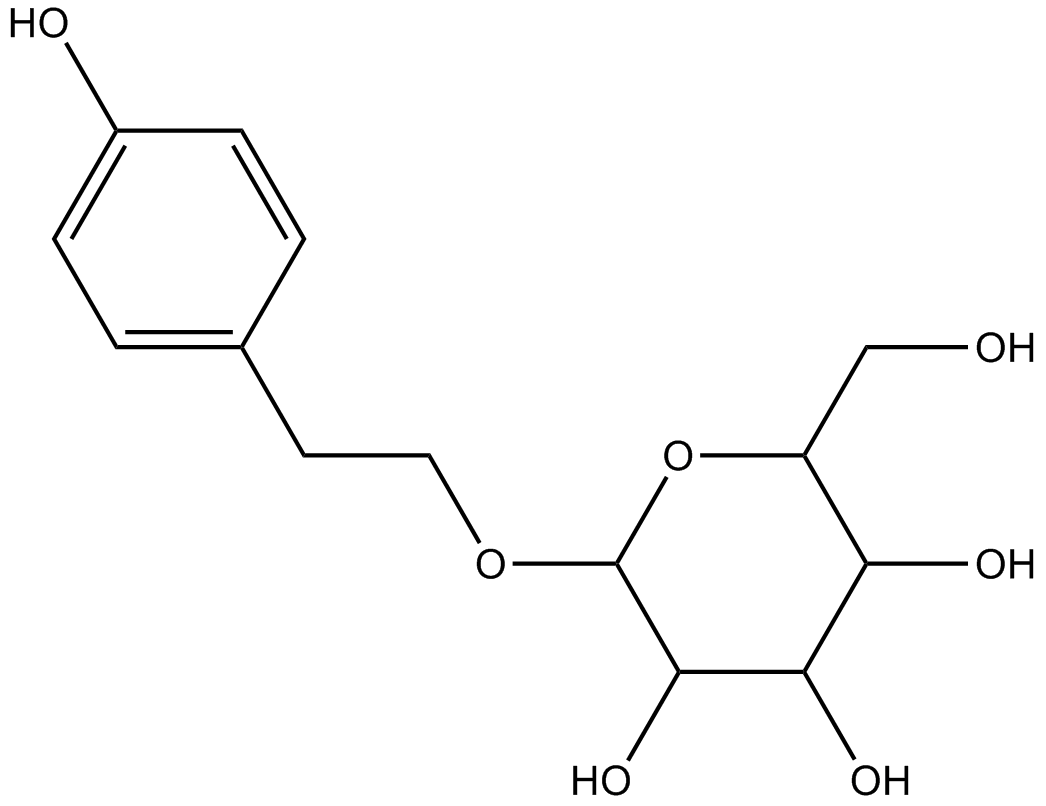Salidroside (Synonyms: Rhodioloside) |
| Catalog No.GN10127 |
Salidroside is a glycoside with multiple biological activities and has pharmacological effects such as anti-cancer, antioxidant, anti-aging, anti-diabetic, anti-diabetic, anti-hypertensive, anti-inflammatory, and immune regulation.
Products are for research use only. Not for human use. We do not sell to patients.

Cas No.: 10338-51-9
Sample solution is provided at 25 µL, 10mM.
Salidroside is a tyrosol glycoside primarily found in the roots of Rhodiola species, exhibiting a wide range of biological and pharmacological properties, including anti-cancer, antioxidant, anti-aging, anti-diabetic, anti-hypertensive, anti-inflammatory, and immunomodulatory effects. Salidroside can improve muscle nutrition by increasing the expression of mTOR, p-mTOR, and MyHC[1]. It alleviates cachexia symptoms in a mouse model of cancer cachexia by activating the mTOR signaling pathway[1]. Furthermore, salidroside protects dopaminergic neurons by enhancing PINK1/Parkin-mediated mitophagy[2]. Its anti-cancer activity is primarily due to the inhibition of the PI3K/AKT, JAK/STAT, and MEK/ERK pathways, as well as the activation of cell apoptosis and autophagy[3].
In vitro, salidroside significantly increases the expression of mTOR, p-mTOR, and MyHC in C2C12 myotubes and can effectively rescue the downregulation of mTOR, p-mTOR, and MyHC expression induced by tumor necrosis factor-alpha[1]. Salidroside (10, 25, and 50µM) significantly prevents MPP+-induced cytotoxicity and reverses the reduction in dopamine, HVA, and DOPAC levels induced by MPTP in the striatum[2]. Additionally, salidroside (100µM) inhibits the activity of prolyl endopeptidase (PEP), an enzyme associated with learning and memory, by 10.6±1.9%[4].
In vivo, salidroside (120 mg/kg/day; i.p.) significantly maintains fat mass and increases lean body mass, especially the mass of the gastrocnemius muscle, indicating a notable improvement in the main features of cancer-associated cachexia in mice[1]. Salidroside (10/20/40 mg/kg/day) also induces a mouse model of testicular damage[5].
References:
[1] Chen X, et al. Salidroside alleviates cachexia symptoms in mouse models of cancer cachexia via activatingmTOR signalling. J Cachexia Sarcopenia Muscle. 2016 May;7(2):225-32.
[2]Li R, et al. Salidroside Protects Dopaminergic Neurons by Enhancing PINK1/Parkin-Mediated Mitophagy. Oxid Med Cell Longev. 2019 Sep 10; 2019: 9341018.
[3] Zhifeng Z , Jing H , Jizhou Z ,et al.Pharmacological activities, mechanisms of action, and safety of salidroside in the central nervous system[J].Drug Design Development & Therapy, 2018, 12:1479-1489.
[4] Fan W, et al. Prolyl endopeptidase inhibitors from the underground part of Rhodiola sachalinensis. Chem Pharm Bull (Tokyo). 2001 Apr;49(4):396-401.
[5] Wang Z, et al. Salidroside Ameliorates Furan-Induced Testicular Inflammation in Relation to the Gut-Testis Axis and Intestinal Apoptosis. J Agric Food Chem. 2023 Nov 9.
Average Rating: 5 (Based on Reviews and 30 reference(s) in Google Scholar.)
GLPBIO products are for RESEARCH USE ONLY. Please make sure your review or question is research based.
Required fields are marked with *




